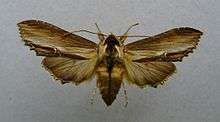Mullein moth
| Mullein moth | |
|---|---|
 | |
| Scientific classification | |
| Kingdom: | Animalia |
| Phylum: | Arthropoda |
| Class: | Insecta |
| Order: | Lepidoptera |
| Family: | Noctuidae |
| Genus: | Cucullia |
| Species: | C. verbasci |
| Binomial name | |
| Cucullia verbasci (Linnaeus, 1758) | |
| Synonyms | |
|
Shargacucullia verbasci | |
The mullein moth, Cucullia verbasci, is a Palearctic noctuid moth.
Description
Forewing broad [for the genus], brownish ochreous; the costal streak and those preceding and following the lower part of outer line deep redbrown; the lunules following the line white and conspicuous; space below median paler, becoming almost whitish above the outer dark brown streak; stigmata marked by dark brown spots; a row of deep brown streaks from apex to vein 6, and another, more faint, from below apex to end of cell; hindwing in male whitish, with dark veins and cellspot, becoming diffusely fuscous along termen; in female darker throughout.[1]
Larva is creamy with black and yellow spots.
Range
It is found in western, southern and central Europe and North Africa. However, there are only individual finds from Denmark and southern Finland in the north. The eastern presence extends to western Afghanistan. It ia also found in Israel and Turkey. In the Alps, it rises up to a height of 1600 meters.
Status
Habitat - Mainly dry and warm places. Scrub, dry grassland, on rocky slopes, steppe as well as parks and gardens.
Habits - Completely strips leaves of host plant.It is a horticultural pest.[2]
Life cycle
Egg
Eggs are laid singly on the under-surface of leaves of food plants. Initially white, they turn grey before hatching.
Caterpillar
.jpg)
The caterpillar is the most commonly encountered part of the life cycle, clearly visible as it feeds on leaves of its host plants (Waring et al., 2003).
The fully grown caterpillar is 44–48 mm long (Porter, 1997).
Pupa
The pupa is the longest part of the life cycle (up to 5 years in captivity). It lives underground in a strong cocoon. (Waring et al., 2003)
Imago
The species displays much variation in size: wingspan ranges between 45 mm and 56 mm. They also show minor variation in colour.
Flight period
The moth flies from late April to June depending on the location.
Host plants
- Buddleja – Buddleia, butterfly bush
- Himantoglossum hircinum – lizard orchid
- Scrophularia – figworts
- Verbascum – mulleins
See Robinson, G. S. et al. .[3]
References
- ↑ Seitz, A. Ed., 1914 Die Großschmetterlinge der Erde, Verlag Alfred Kernen, Stuttgart Band 3: Abt. 1, Die Großschmetterlinge des palaearktischen Faunengebietes, Die palaearktischen eulenartigen Nachtfalter, 1914
- ↑ David V Alford,2012 Pests of Ornamental Trees, Shrubs and Flowers: A Colour Handbook, Second Edition 2012 Manson Pub Ltd ISBN 978-1840761627
- ↑ "Robinson, G. S., P. R. Ackery, I. J. Kitching, G. W. Beccaloni & L. M. Hernández, 2010. HOSTS - A Database of the World's Lepidopteran Hostplants. Natural History Museum, London.".
- Bretherton, R.F., B. Goater and R.I. Lorimer (1983) Noctuidae: Cucilliinae to Hypeninae. Pages 49–52 in John Heath, A. Maitland Emmet et al. (Ed.) The Moths and Butterflies of Great Britain and Ireland, Vol. 10: Noctuidae (Cucilliinae to Hypeninae) and Agaristidae. Harley Books, Colchester, UK.
- Waring, Paul, Martin Townsend and Richard Lewington (2003) Field Guide to the Moths of Great Britain and Ireland. British Wildlife Publishing, Hook, UK. ISBN 0-9531399-1-3
- Chinery, Michael Insects of Britain and Western Europe. Collins. ISBN 0-00-219137-7
External links
| Wikimedia Commons has media related to Cucullia verbasci. |
- Lepiforum
- Funet Taxonomy
- Fauna Europaea
- UKMoths Mullein page
- Royal Horticultural Society advice on Mullein Moth pest control.
- English Nature page on Mullein Moth